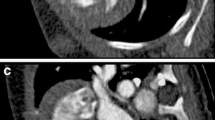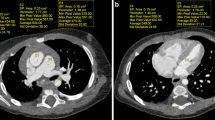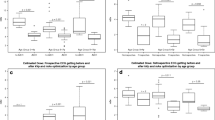Abstract
Objectives
To evaluate image quality (IQ) of low-radiation-dose paediatric cardiovascular CT angiography (CTA), comparing iterative reconstruction in image space (IRIS) and sinogram-affirmed iterative reconstruction (SAFIRE) with filtered back-projection (FBP) and estimate the potential for further dose reductions.
Methods
Forty neonates and children underwent low radiation CTA with or without ECG synchronisation. Data were reconstructed with FBP, IRIS and SAFIRE. For ECG-synchronised studies, half-dose image acquisitions were simulated. Signal noise was measured and IQ graded. Effective dose (ED) was estimated.
Results
Mean absolute and relative image noise with IRIS and full-dose SAFIRE was lower than with FBP (P < 0.001), while SNR and CNR were higher (P < 0.001). Image noise was also lower and SNR and CNR higher in half-dose SAFIRE studies compared with full-and half-dose FBP studies (P < 0.001). IQ scores were higher for IRIS, full-dose SAFIRE and half-dose SAFIRE than for full-dose FBP and higher for half-dose SAFIRE than for half-dose FBP (P < 0.05). Median weight-specific ED was 0.3 mSv without and 1.36 mSv with ECG synchronisation. The estimated ED of half-dose SAFIRE studies was 0.68 mSv.
Conclusions
IR improves image noise, SNR, CNR and subjective IQ compared with FBP in low-radiation-dose paediatric CTA and allows further dose reductions without compromising diagnostic IQ.
Key Points
• Iterative reconstruction techniques significantly improve non-invasive cardiovascular CT in children.
• Using half traditional radiation dose image quality is higher with iterative reconstruction.
• Iterative reconstruction techniques may allow further radiation reductions in paediatric cardiovascular CT.



Similar content being viewed by others
Abbreviations
- CNR:
-
Contrast/Noise Ratio
- CTA:
-
CT angiography
- ECG:
-
Electrocardiogram
- ED:
-
Effective radiation dose equivalent
- FBP:
-
Filtered back projection
- HU:
-
Hounsfield units
- IQ:
-
Image quality
- IRIS:
-
Iterative reconstruction in image space
- ROI:
-
Region of interest
- SAFIRE:
-
Sinogram affirmed iterative reconstruction
- SD:
-
Standard deviation
- SNR:
-
Signal-to-noise ratio
- VRT:
-
Volume-rendered technique
References
Hoffman JI, Kaplan S (2002) The incidence of congenital heart disease. J Am Coll Cardiol 39:1890–1900
Paul JF, Rohnean A, Sigal-Cinqualbre A (2010) Multidetector CT for congenital heart patients: what a paediatric radiologist should know. Pediatr Radiol 40:869–875
Yang M, Mo XM, ** JY et al (2011) Image quality and radiation exposure in pediatric cardiovascular CT angiography from different injection sites. AJR Am J Roentgenol 196:117–122
Fogel MA, Pawlowski TW, Harris MA et al (2011) Comparison and usefulness of cardiac magnetic resonance versus computed tomography in infants six months of age or younger with aortic arch anomalies without deep sedation or anesthesia. J Am Coll Cardiol 108:120–125
Krishnamurthy R (2009) The role of MRI and CT in congenital heart disease. Pediatr Radiol 39(Suppl 2):196–204
Haselgrove JC, Simonetti O (1998) MRI for physiology and function: technical advances in MRI of congenital heart disease. Semin Roentgenol 33:293–301
Bailliard F, Hughes ML, Taylor AM (2008) Introduction to cardiac imaging in infants and children: techniques, potential, and role in the imaging work-up of various cardiac malformations and other pediatric heart conditions. Eur J Radiol 68:191–198
Hollingsworth CL, Yoshizumi TT, Frush DP et al (2007) Pediatric cardiac-gated CT angiography: assessment of radiation dose. AJR Am J Roentgenol 189:12–18
Herzog C, Mulvihill DM, Nguyen SA et al (2008) Pediatric cardiovascular CT angiography: radiation dose reduction using automatic anatomic tube current modulation. AJR Am J Roentgenol 190:1232–1240
Ben Saad M, Rohnean A, Sigal-Cinqualbre A, Adler G, Paul JF (2009) Evaluation of image quality and radiation dose of thoracic and coronary dual-source CT in 110 infants with congenital heart disease. Pediatr Radiol 39:668–676
Leschka S, Oechslin E, Husmann L et al (2007) Pre- and postoperative evaluation of congenital heart disease in children and adults with 64-section CT. Radiographics 27:829–846
Spevak PJ, Johnson PT, Fishman EK (2008) Surgically corrected congenital heart disease: utility of 64-MDCT. AJR Am J Roentgenol 191:854–861
Brenner DJ (2002) Estimating cancer risks from pediatric CT: going from the qualitative to the quantitative. Pediatr Radiol 32:228–223
Brenner DJ, Elliston CD, Hall EJ, Berdon WE (2001) Estimates of the cancer risks from pediatric CT radiation are not merely theoretical: comment on “point/counterpoint: in x-ray computed tomography, technique factors should be selected appropriate to patient size. against the proposition”. Med Phys 28:2387–2388
Prakash P, Kalra MK, Ackman JB et al (2010) Diffuse lung disease: CT of the chest with adaptive statistical iterative reconstruction technique. Radiology 256:261–269
Marin D, Nelson RC, Schindera ST et al (2010) Low-tube-voltage, high-tube-current multidetector abdominal CT: improved image quality and decreased radiation dose with adaptive statistical iterative reconstruction algorithm–initial clinical experience. Radiology 254:145–153
Vorona GA, Ceschin RC, Clayton BL, Sutcavage T, Tadros SS, Panigrahy A (2011) Reducing abdominal CT radiation dose with the adaptive statistical iterative reconstruction technique in children: a feasibility study. Pediatr Radiol 41:1174–1182
Friedman BA, Schoepf UJ, Bastarrika GA et al (2009) Computed tomographic angiography of infants with congenital heart disease receiving extracorporeal membrane oxygenation. Pediatr Cardiol 30:1154–1156
Bittencourt MS, Schmidt B, Seltmann M et al (2011) Iterative reconstruction in image space (IRIS) in cardiac computed tomography: initial experience. Int J Cardiovasc Imaging 27:1081–1087
Moscariello A, Takx RA, Schoepf UJ et al (2011) Coronary CT angiography: image quality, diagnostic accuracy, and potential for radiation dose reduction using a novel iterative image reconstruction technique-comparison with traditional filtered back projection. Eur Radiol 21:2130–2138
Winklehner A, Karlo C, Puippe G et al (2011) Raw data-based iterative reconstruction in body CTA: evaluation of radiation dose saving potential. Eur Radiol 21:2521–2526
Pontana F, Duhamel A, Pagniez J et al (2011) Chest computed tomography using iterative reconstruction vs filtered back projection (Part 2): image quality of low-dose CT examinations in 80 patients. Eur Radiol 21:636–643
Szucs-Farkas Z, Strautz T, Patak MA, Kurmann L, Vock P, Schindera ST (2009) Is body weight the most appropriate criterion to select patients eligible for low-dose pulmonary CT angiography? Analysis of objective and subjective image quality at 80 kVp in 100 patients. Eur Radiol 19:1914–1922
Kalra MK, Maher MM, Toth TL, Kamath RS, Halpern EF, Saini S (2004) Comparison of Z-axis automatic tube current modulation technique with fixed tube current CT scanning of abdomen and pelvis. Radiology 232:347–353
Kalra MK, Maher MM, Blake MA et al (2005) Detection of urinary tract stones at low-radiation-dose CT with z-axis automatic tube current modulation: phantom and clinical studies. Radiology 235:523–529
Thomas KE, Wang B (2008) Age-specific effective doses for pediatric MSCT examinations at a large children’s hospital using DLP conversion coefficients: a simple estimation method. Pediatr Radiol 38:645–656
Guillerman RP (2011) Newer CT applications and their alternatives: What is appropriate in children? Pediatr Radiol 41(Suppl 2):534–548
Feng ST, Law MW, Huang B et al (2010) Radiation dose and cancer risk from pediatric CT examinations on 64-slice CT: a phantom study. Eur J Radiol 76:19–23
Fujii K, Aoyama T, Koyama S, Kawaura C (2007) Comparative evaluation of organ and effective doses for paediatric patients with those for adults in chest and abdominal CT examinations. Br J Radiol 80:657–667
Lin MT, Wang JK, Chen YS et al (2011) Detection of pulmonary arterial morphology in tetralogy of Fallot with pulmonary atresia by computed tomography: 12 years of experience. Eur J Pediatr 171:579–586
Pache G, Grohmann J, Bulla S et al (2011) Prospective electrocardiography-triggered CT angiography of the great thoracic vessels in infants and toddlers with congenital heart disease: Feasibility and image quality. Eur J Radiol 80:440–445
O’Daniel JC, Stevens DM, Cody DD (2005) Reducing radiation exposure from survey CT scans. AJR Am J Roentgenol 185:509–515
Heyer CM, Mohr PS, Lemburg SP, Peters SA, Nicolas V (2007) Image quality and radiation exposure at pulmonary CT angiography with 100- or 120-kVp protocol: prospective randomized study. Radiology 245:577–583
Entrikin DW, Leipsic JA, Carr JJ (2011) Optimization of radiation dose reduction in cardiac computed tomographic angiography. Cardiol Rev 19:163–176
Gervaise A, Osemont B, Lecocq S et al (2012) CT image quality improvement using adaptive iterative dose reduction with wide-volume acquisition on 320-detector CT. Eur Radiol 22:295–301
Renker M, Nance JV, Schoepf UJ et al (2011) Evaluation of heavily calcified vessels with coronary CT angiography: comparison of iterative and filtered back projection image reconstruction. Radiology 260:390–399
Leipsic J, Labounty TM, Heilborn M et al (2010) Estimated radiation dose reduction using adaptive statistical iterative reconstruction in coronary CT angiography: the ERASIR study. AJR Am J Roentgenol 195:655–660
Paul JF, Rohnean A, Elfassy E, Sigal-Cinqualbre A (2011) Radiation dose for thoracic and coronary step-and-shoot CT using a 128-slice dual-source machine in infants and small children with congenital heart disease. Pediatr Radiol 41:244–249
Acknowledgements
UJS is a consultant for and receives research support from Bayer, Bracco, GE, Medrad and Siemens. The other authors have no conflicts of interest to disclose.
Author information
Authors and Affiliations
Corresponding author
Rights and permissions
About this article
Cite this article
Tricarico, F., Hlavacek, A.M., Schoepf, U.J. et al. Cardiovascular CT angiography in neonates and children: Image quality and potential for radiation dose reduction with iterative image reconstruction techniques. Eur Radiol 23, 1306–1315 (2013). https://doi.org/10.1007/s00330-012-2734-5
Received:
Revised:
Accepted:
Published:
Issue Date:
DOI: https://doi.org/10.1007/s00330-012-2734-5




